
‘Peter Greenaway was born in Newport, Wales in 1942. He studied at Forest Hills Public School, and then at Walthamstow College of Art. Described as an artist who is a believer in the subversive power of the image, his critical relation to visualisation is expressed in paintings, films, television and multi-media formats, that have earned him international acclaim as well as charges of mannerism, elitism, obscurantism, intellectual exhibitionism, even misogyny.
‘Greenaway has come to be recognized as a philosopher of cinema, since the style and substance of his work addresses the changing status of the image in the contemporary world. His films draw self-consciously on various arts – painting, literature, calligraphy, theatre, architecture, and music – however, they are not merely formal exercises in style. Though they are obsessed with the nature and importance of form, they address profound questions of the historical role of art in culture.
‘Greenaway’s work is critical of Hollywood methods of filmmaking that he sees as mere illustration of nineteenth century novels. For him, cinema must resist appropriating existing novels and plays. His early films are “not illustrations of already existing texts, or vehicles for actors, or slaves to a plot, or an excuse to provide emotional catharsis”, as Alan Woods puts it.
‘The non-feature films and videos that he made from the 1960s into the 1980s can be described rather as “theoretical deliberations”. They are encyclopaedic in scope, visualising aspects of modern life, e.g., transportation, funeral architecture, telephone boxes, rural and ancient, domestic and public landscapes, dress designers, composers, lakes, water towers, roads, conspiracies, riots and demonstrations, etc. However, these films are not conventional documentaries but Greenaway’s mode of subverting realism, of highlighting the theatricality and artifice of the visual image so as to enable an understanding of the “vast amount of data that’s pushed at us all the time”.
‘The Draughtsman’s Contract (1982), Greenaway’s first mainstream feature film, is set in the seventeenth century, a time of social and economic transformation. The film portrays the draughtsman’s encounters with the moneyed upper classes as he seeks to fulfill his commission. Though the film involves intrigue, even murder, it is not a conventional crime narrative. It is a whodunit that is also a complex exploration of the production of the visual image and its relation to sound, particularly music (thanks to Greenaway’s collaboration with Michael Nyman). It examines perspective through the visual and verbal references to painting – the focus on framing of the drawings and of the film itself, on conversations that are as stylised as the images of architecture and formal gardens. In effect, the film uses all of these strategies to invite the spectator to consider different ways of visualising history, contemplating language, storytelling, and, above all, cinema.
‘A Zed and Two Noughts (1985) captures similar images of nature and artifice to those Greenaway created in his short ‘documentaries’. The film involves twins, Oliver and Oswald, but the narrative is not a story; it is a compendium of animals as in the zoo of the title. But Greenaway’s zoo is the world, and, more specifically, the world of cinema. The cinematic and philosophical focus is on the world as reflected, on issues of sameness (as in the case of identical twins), emerging from the dualities of cinema and reality, art and nature, forgery and authenticity. Greenaway also introduces a motif from his other films – mortality seen through the lens of the cinema that both captures death and is itself doomed to decay and death.
‘According to Greenaway, The Belly of an Architect (1986), his third feature film “has tried to explore all the different means whereby art has produced the human form”. The film reprises Greenaway’s ubiquitous and complex motif of doubling with two architects, one an eighteenth century historical personage, Etienne-Louis Boullée, the other a contemporary American, Stourley Kracklite, who has come to Rome to set up an exhibit of Boullée. Greenaway seeks further doubling in the film’s conjunction of past and present, particularly in the linking of Boullée’s buildings to Fascist architecture and by linking architects to filmmakers in relation to the dilemmas they face in being dependent on patrons while attempting to express their own personal and cultural vision.
‘Drowning by Numbers (1988), Greenaway’s next film, is generally regarded as more accessible to spectators than his other narratives. The film involves three women dissatisfied with their husbands and determined to do something with their disaffection – through death by drowning. By this act, the women develop “a deeper form of kinship” and “a primordial affinity with water”. As the film’s title suggests, the film relies on the elemental nature of water. The numbers alluded to in the title involve the doubling and tripling of characters, the four elements, the visual presence of ciphers, and the frequent allusions to counting. In Greenaway’s films numbers play a prominent role, having to do with complex modes of ordering the world and are tied to modes of representation – classification, taxonomy, and symbolisation – that are scientific and visionary.
‘The Cook, The Thief, His Wife, and Her Lover (1989), made during the last years of Thatcherism, was commercially his most successful film and revealed Greenaway’s penchant for allegory and his ability to combine political with cultural critique. The film draws on popular images of crime and violence, food and fashion, and links them to Thatcher’s England. The focus on consuming is not only a critique of contemporary capitalism as gangsterism, but of the violence of history as conveyed through the fictions by which it is consumed,
‘Prospero’s Books (1991) carries Greenaway’s investigation of representation to greater complexity. The film engages with Shakespeare’s The Tempest, not as theatre transposed to film but rather – through the overarching figure of Prospero (Sir John Gielgud) – with issues of art and science, human intelligence, the powers of reason and unreason. The most striking aspect of the film has to do with role of “books”, the archive of human knowledge, covering the natural sciences, history, magic, painting, and calligraphy. Prospero’s Books is exemplary of Greenaway’s encyclopedic strivings. The “books” are the artist’s archive and are also indicative of the potential of cinema to capture the multiplicity of life and thought. Utilising allegory, the film draws on visual images, dialogue and music to invoke theatre, masque, opera, high and low comedy and create a complex vision of authorship, cinematic narration and the clash between words and images.
‘The Baby of Mâcon (1993) draws on a play performed in Italy in 1659 and focuses on the slippery relation between theatrical illusion and ‘reality’ within the performance of a play, exploring the complex role of ritual (and cinema), in Greenaway’s terms, as both “paradoxical and dangerous”, an opportunity for critical reflection or an instrument of deceit and manipulation.
‘In creating The Pillow Book (1995) Greenaway follows another trajectory, pursuing connections between writing and the body: the body of thought, the body of writing, and the body as writing. Working with a thousand year-old diary, The Pillow Book of Sei Shonagan, he reshapes the text to address his primary aesthetic and philosophical concerns. As both this allegory and Prospero’s Books suggest, Greenaway is wrestling with relations between word and image: Japanese calligraphy provides him, as it did earlier for Sergei Eisenstein, with a rethinking of the separation of the body and the text. The film is a cornucopia of images and allusions: Greenaway explores within the film and in the form of the film the creation of new languages, generating different visual effects with framing, multiple screen images, letter-boxing, overlaid texts, writing superimposed on visual images as well as writings on the body of the actors.
‘Consistent with his exploration of media and language, Greenaway’s later films – 8½ Women, Death of a Composer (both 1999), The Man in the Bath (2001) and Tulse Luper’s Suitcase (2002) – rely on new media, particularly CD-ROM. Greenaway continues to expand his exploration of the various arts, their interconnections, the historical changes that must be acknowledged and their implications for understanding the relationship between expression and power.’ — bfi
____
Stills
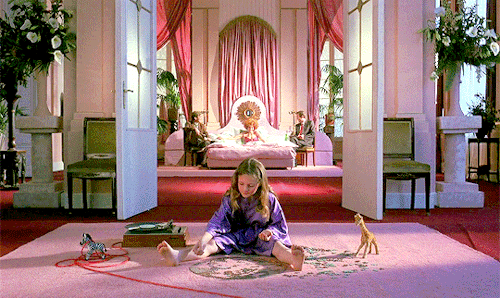

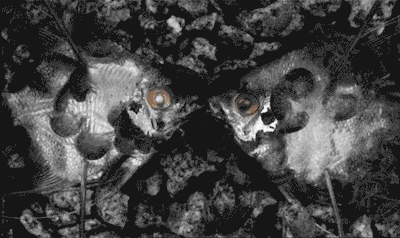
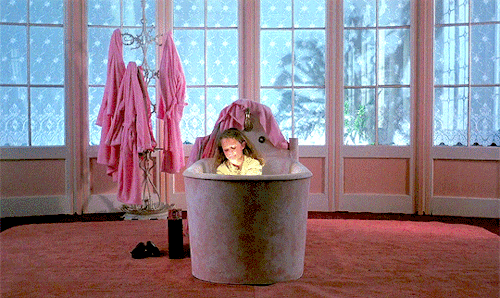
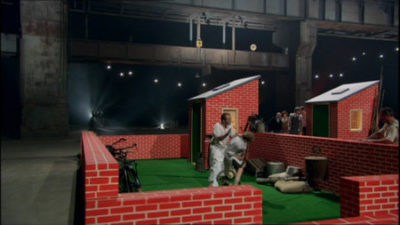
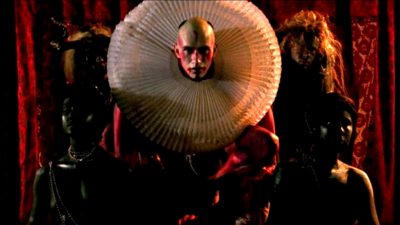
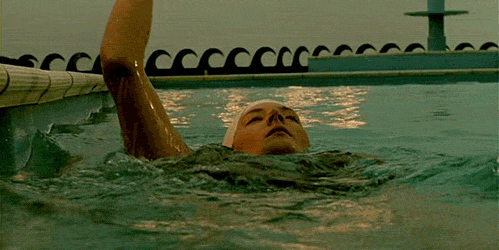
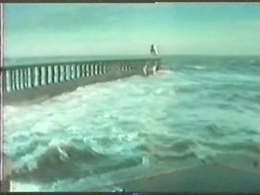
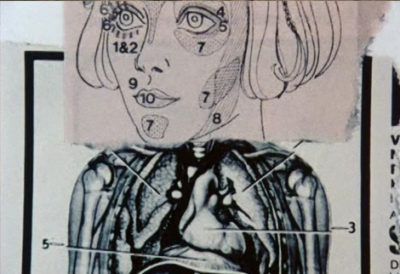


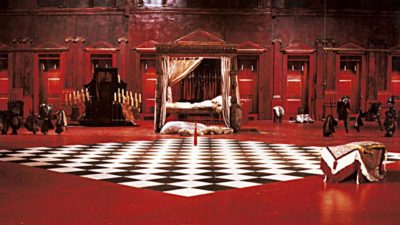

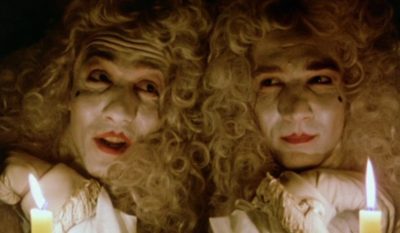
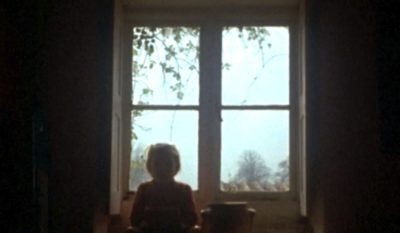

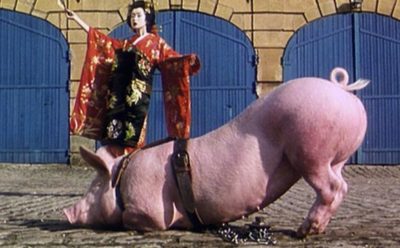
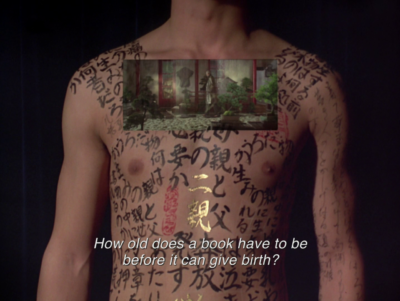
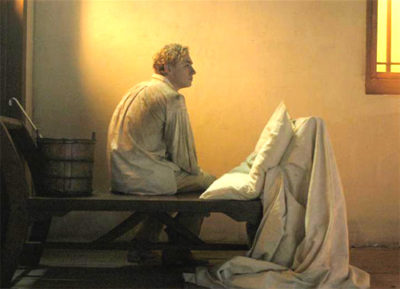

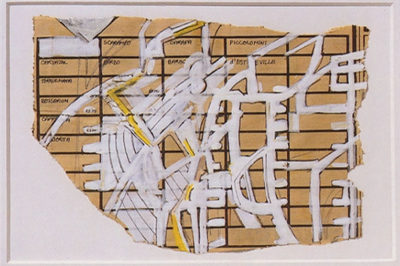


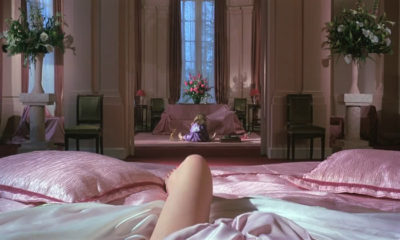



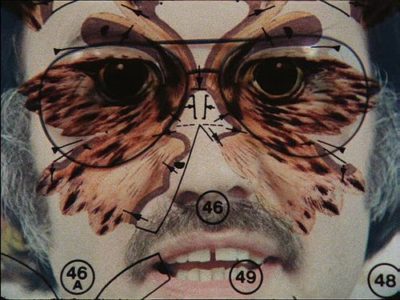
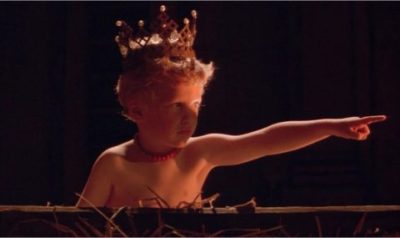
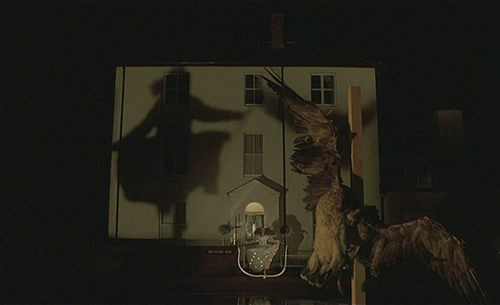


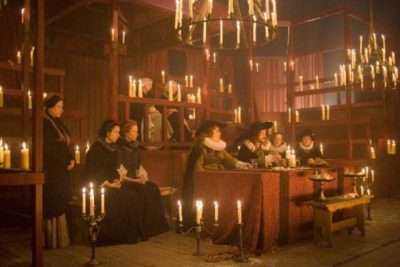
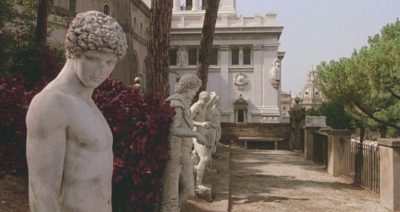

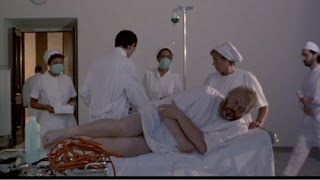


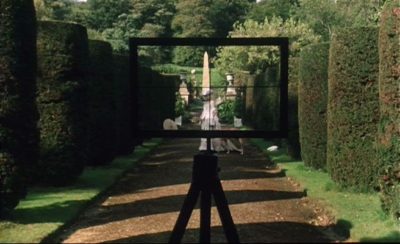


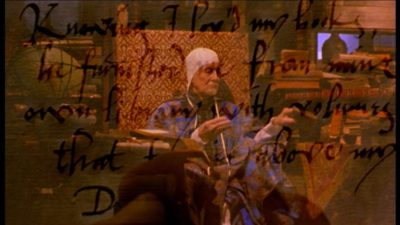




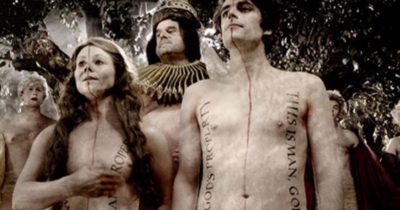

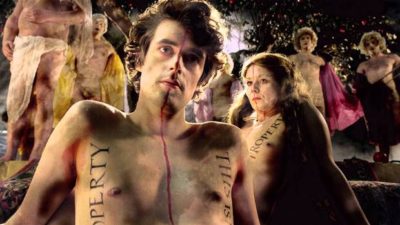

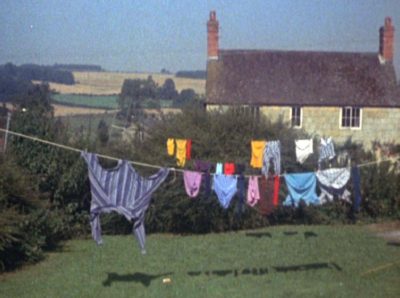
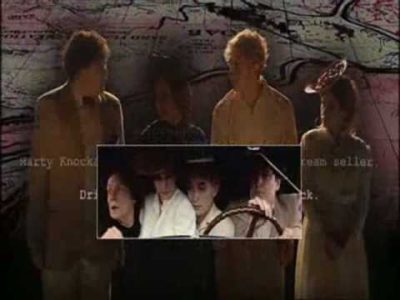

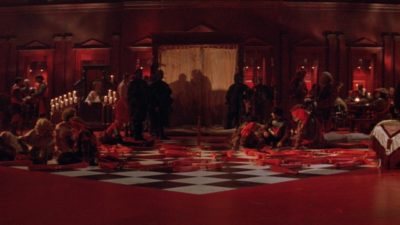

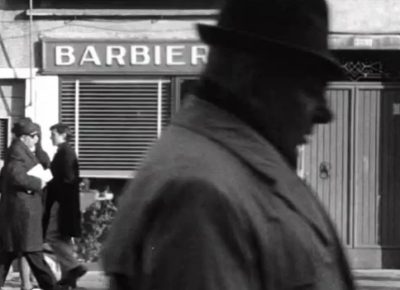

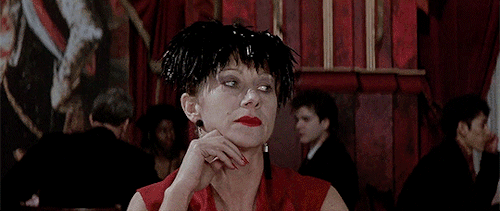
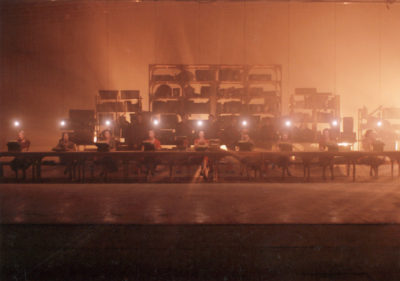



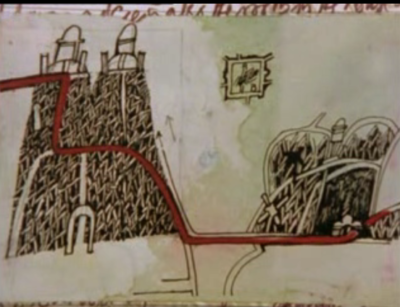

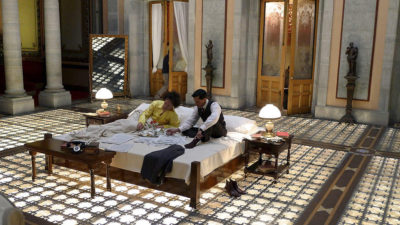
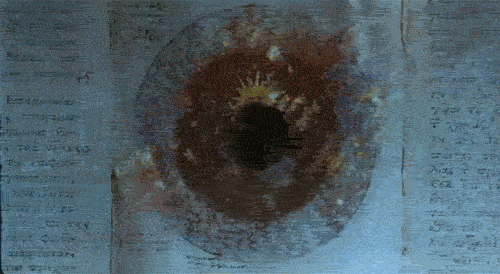
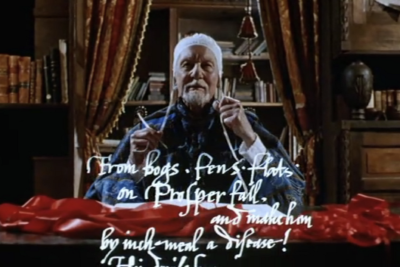
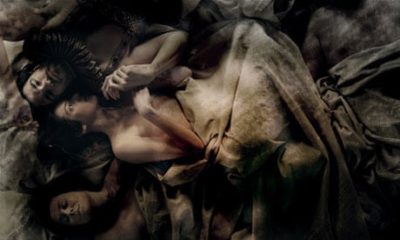
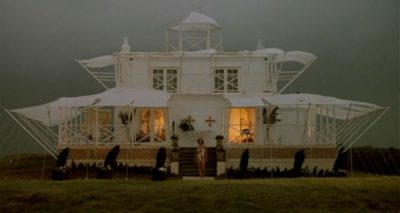
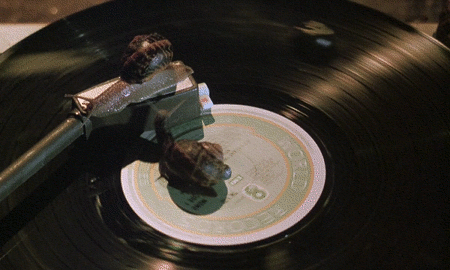
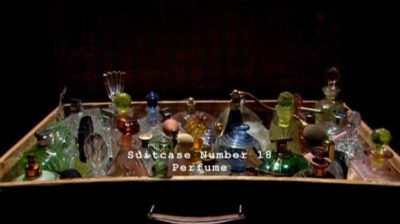


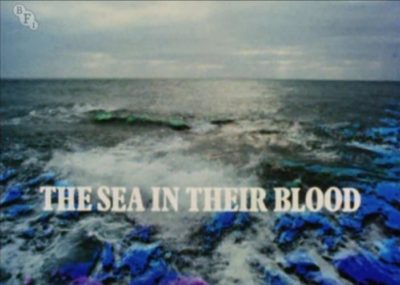
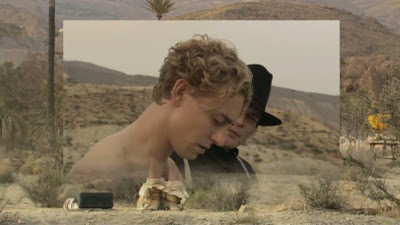
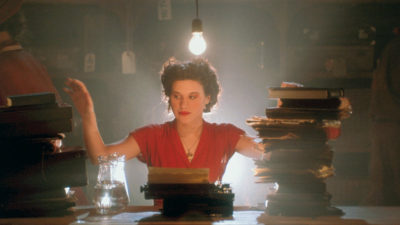
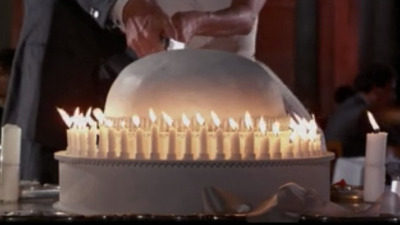
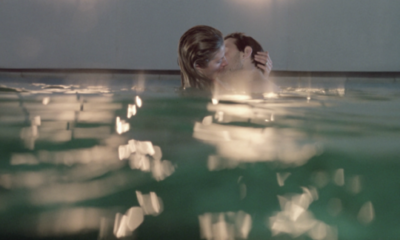
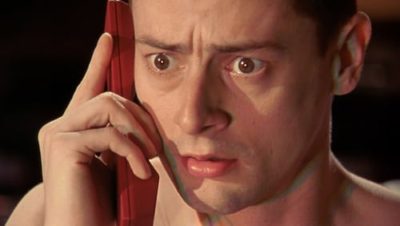
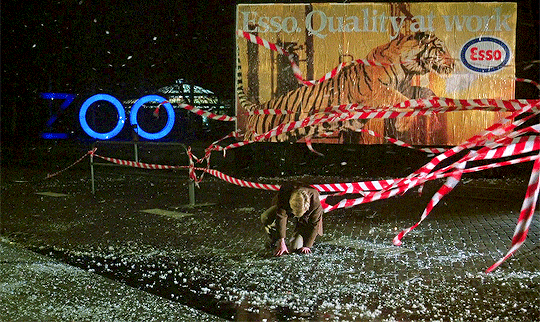
____
Further
Peter Greenaway @ IMDb
Peter Greenaway plans racetrack in tribute to Jack Kerouac book
Peter Greenaway @ Twitter
Book: Peter Greenaway ‘Papers’
“THE IMAGE ALWAYS HAS THE LAST WORD”. CINEMA ACCORDING TO PETER GREENAWAY
Peter Greenaway, the arch-defenestrator
Tulse Luper Database: Peter Greenaway, the New Media Object and the Art of Exhaustion
LEONARDO’S LAST SUPPER: A VISION BY PETER GREENAWAY
Book: ‘The Films of Peter Greenaway’
Peter Greenaway @ MUBI
Video: SACHA VIERNY – PETER GREENAWAY : UNE COLLABORATION EXEMPLAIRE
Peter Greenaway @ Fandor
Entretien avec Peter Greenaway
Book: Peter Greenaway – The Dance Of Death
Peter Greenaway: I’ve seven productive years left to finish 30 projects
CAN I INVITE GOD TO MY LAST SUPPER?
Peter Greenaway : “le cinéma est devenu un art bâtard dans lequel l’écrit domine”
PETER GREENAWAY AND CINEMA AS A MUSICALIZED PAINTING
“I Argue that Cinema is Either Dying or Dead”
Greenaway announces the death of cinema – and blames the remote-control zapper
Peter Greenaway interviewed by Lawrence Chua
Peter Greenaway on Art, Cinema, Sex, and Religion (Q&A)
In Excess of the Cut: Peter Greenaway’s “Eisenstein in Guanajuato”
____
Extras
Peter Greenaway: “Nine Classic Paintings Revisited”
Peter Greenaway CBE – Where Next for Storytelling
Peter Greenaway. The Slavery of Music and Sound. 2002
_____
Interview
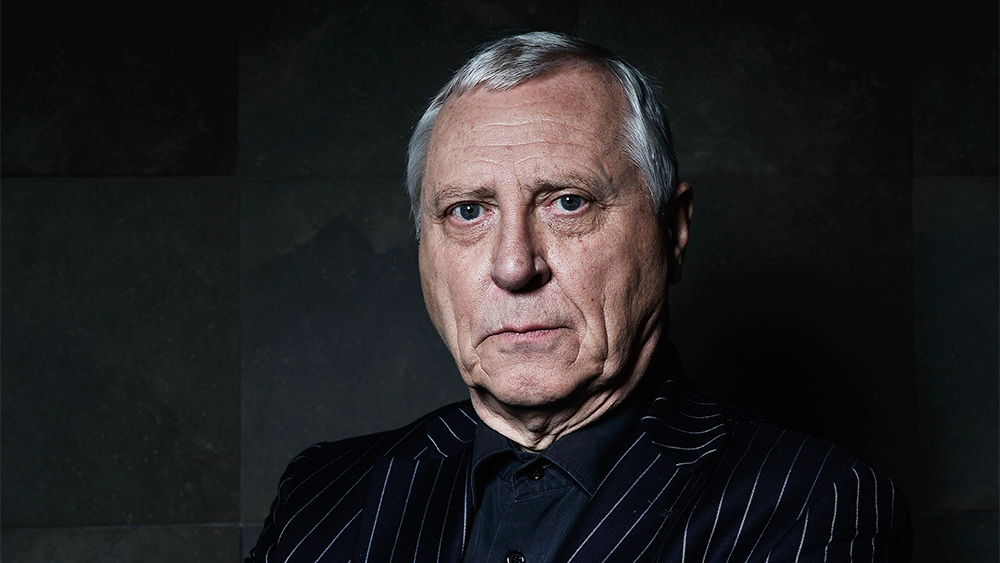
I read a statement that you made once. In comparing film and literature, you said that literature was interior,” and was thus a purer art form than film. We were just talking with Mr. Audi [Director of the Netherlands Opera] about the imperfections of opera as an art form, as an attempt to bring together drama and music. Do you ever regret that you became a filmmaker, rejecting the ” vocations of writer or painter?
I was trained as a painter. And although it often sounds very ,”I still consider myself a painter, but one who happens to be working in cinema. There are all sorts of contradictions going on there, of course. I also had a classic English literary education, and although many people consider me a visualist–someone capable of putting together a picture–I would like to think also that the dialogue and the soundtracks in my films are of eminent importance. Was it Truffaut who suggested that cinema” was a contradictory term? There is almost a way in which painting” is a contradiction in terms; I suppose our contribution to the world of painting is very, very small, compared, indeed, with this country, and certainly with France and Italy. The average painting which was hung in the Royal Academy in the seventeenth century was probably accompanied by about seventeen pages of text. Questions regarding text and the image are endemic to the English culture, and they are certainly my big concerns, as well. One of my great disappointments was to realize that 95% of all images are illustrations of text. And even after the revolutions in painting in the nineteenth century, you still have to use words to describe paintings. Paintings are still given titles, which are basically textural, and which entirely colour the way in which the painting is viewed. So if you want to be a visual creator,” it’s a great frustration.
I would say there has been no cinema yet. Nobody has yet made a film. I think the best we can manage is a version of illustrated literature or recorded theatre. Alain Resnais [the French filmmaker, creator of Hiroshima, mon amour and L’annee derniere a Marienbad], for me, has probably come the closest of any filmmaker to make a film which canot be manifested in any other art form. I also think that the dominant commercial cinema is extremely conventional, very orthodox, very non-investigative; Scorsese, basically, is still making the same movies as Griffith. But I’m not down-hearted about this, because just around the corner, after a hundred years of this prologue to cinema which we’ve had, is the possibility of at last being able to make pure cinema, with all the new technologies. Virtual reality, the IMAX screen, the whole digital revolution is going to allow us to make actual cinema. You might recall that occasion when Eisenstein, of all people, said to Walt Disney that Disney was the only man that really made films, because the entire filmic universe was created completely within his imagination, and not with reference to the real world.
Most of my cinema, I suppose, has been, again, agonizing about this difference that’s existed in the West–this division between text and image, and the hopeful ability of cinema to unite them. Again, I don’t think it ever has successfully. As an addendum to that, the next product which I hope will filmically extend this idea is a movie that we’re about to make in Japan, which is essentially about calligraphy: how calligraphy, an Oriental tradition–possibly an Islamic tradition–has been able to avoid the divorce between text and image, and in a very unified way. Little essays in this direction were already made in Prospero’s Books, with its concern for the art of calligraphy, for what it meant and stood for. Sadly, calligraphy no longer exists in the Western world, not to any appreciable extent, anyway.
Here again, in this opera, we have the divisions between various forms of representation, using the four hundred-year-old suspension of disbelief which is part and parcel of opera, in association with the suspension of disbelief which is part of the cinematic tradition. So there’s a way in which I’d like to describe this project not as an ,” but as a. . . There’s a searching, a groping, for new words here–not just by me, but by all of us, I think, as a community–for notions of -cinema,” the complete artwork, which of course has potentially been on the scene for perhaps thirty or forty years, but which still hasn’t reached any useful synthesis. Wagner’s notion as opera as being a complete artwork has long been a hovering image of what might, possibly, be possible. Cinema, at the beginnings, certainly with the French in the 1920s, was supposed to be the total artwork: but it’s failed, dismally, to produce the goods.
So, here, maybe, within this view of music theatre in association with the other ways of manufacturing images, might, possibly, be the beginnings of an association which might flower into something and strange,” to quote Caliban [sic.]. Having seen a hundred years of cinema–and a hundred years is far long enough for a prologue–it must get out of its diapers now and do something really interesting.
I find it difficult to place you within the film history textbook that I read as a child. It’s clear from your technique that you value a certain artificiality in your films. Your filmmaking style seems to have been hardly influenced at all by either Germanic expressionism, which largely decided Western cinema’s principles of cinematography and decor, or the Russian school, which largely decided film grammar in the combining of successive images. Yet there are some filmmakers who use some of the same techniques you favor–the stationary camera, a consciousness of the frame, and long takes. I am thinking, for example, of three very different filmmakers: Kubrick, Ozu, and Tarkovskij. When you made the transition into film, were you influenced by any of these filmmakers, or any others?
Probably not. I was much more influenced by the aesthetics of painting than by direct associations with filmmaking products. I think that’s probably manifested in most of my movies. All the early movies were very, very static. In The Draughtman’s Contract, I think the camera moves once, in the dining table sequence–and that in a deliberately -movement” fashion, because it takes no cognizance at all of the activity around it, almost ignores it; the camera is moved almost just for the sake of moving the camera, to say, I can move the camera! It can be moved!” It doesn’t necessarily have to be in total synchronous accord with the drama. My camera has, of course, moved much more in the recent films. I’ve become interested in notions of a choreographed, almost balletic sense of space, although the camera still retains a diffidence. It doesn’t swoop across the floor and go up Robert Redford’s nose, it doesn’t follow the actor into the lavatory in that peculiar, St. Vitus’ dance of contemporary cinema. If the camera moves, it must do so for a very good reason indeed.
And when my camera does move, it moves with a static frame. So it literally is a tracking shot, as seen through a very apparent, self-reflective frame. Prospero’s Books is full of that notion of drawing your attention to the edges of the phenemenon. Of course some people feel that I’m stuck in the seventeenth century. But the concern for the frame is very much a twentieth-century concern: the whole notion–I suppose a post-cubist notion–of acknowledging where the painting stops and starts, its physicality, its relationship to the edges. The nineteenth-century illusion of the painting as a window on the world is not, I think, operating in my cinema. It’s a cinema which does concern itself with the edges, all the time.
Here we are in a theatre. The theatre uses a proscenium; but there are attempts, literally, to break the hymen, through the looking-glass, that way [gestures forward from the stage to the audience]; and also, peripherally, attempts to acknowledge the apron [gestures towards the wings]. I’ve been fascinated by this breakage of the frame because I think, again, after a hundred years–or should we say, after four hundred years–of the dominance of the frame, we’re about to see it exploded. As a filmmaker, I have a choice of maybe six or seven different aspect ratios (if we forget, for the moment, high defintion television coming up from Japan). The way most people see reconstructed drama right now is in a box with a ratio of 1 to 1.33. In a sense, all the freedoms of a chosen ratio have been denied the artist: he’s fixed in this little, tiny straightjacket. And, I suppose, it’s indicative of the way nature works that there would be a suppression, and then an explosion. I think it’s happening already. Ever since American Expressionism, post-American expressionism, the frame has begun to disappear in painting. And I suppose with virtual reality you don’t need a frame anymore; with IMAX and Omnimax, the edge is beyond the periphery of vision. So after a hundred years of cinema, it’s about time that those explosions, those resurrections, those reorganizations of filmic space in terms of the frame, are going to have to disappear. There’s every evidence that other people, too, are concerned about that.
Was this what attracted you to John Cage? It was your interest in Cage that led you to meet Pierre Audi, the director of the Netherlands Opera, a meeting that eventually led to your four short television documentaries on American composers [Four American Composers, 1983].
Well amongst many, many other things, yes. His personal aesthetic; an artistic guru, not necessarily because of what he actually made in terms of music, much of which is deeply unlistenable to, but as a man who had thousands of ideas, who was interested in the cross-referencing, all the time, between the visual world and the aural world.
Do you watch a lot of movies now?
No, hardly ever. I find cinema extremely boring. The exciting, investigative things are not happening in cinema, although they continue to be happening in painting. Certainly in literature, and in still photography, too; but it’s very, very rare indeed to find an exciting film.
Getting back to Cage, for just a moment: for Cage, the disappearance of the frame meant nothing less than the disappearance of art itself, art being predicated upon the tension between an inside and an outside of a frame. That tension is exactly analogous to the tension between the artist and the audience, or, more generally, between subject and object. That tension is necessary for there to be a communication, a transference of a substance, from one form to another. Cage isolated and showed us that structure of transference, without the process of a transfer. He went past the need, or the desire, for such a process. In doing that he was revolutionary. In this respect it would seem impossible to follow in Cage’s footsteps as a significant artist. To call oneself an artist and yet not produce would hardly, after Cage, have a revolutionary impact.
I want to link this problem with the use of technology, as you already have. Technology as a force that is continually driving to communication and the covering of distance would obviously appear to be moving towards the infinite limit of abolishing the frame, which here is understood, again, as the tension between subject and object.
Well there is post-Cageian music. Music goes on; the inventive spirit is still alive. You need not be frightened by endings. All this talk of the end of the novel, for example, or the end of painting. . .
Chronologically, it’s true that there exist composers after Cage; but artistically I’m not sure if that’s true.
Oh, I’m sure that it is. I’m sure that that’s not so much a full stop as much as a comma, a very important comma. But the continuation of the desire for musical excitement in whatever sphere, for whatever simulus, is, I’m sure, going to be able to create new forms, new approaches.
You seem, by your question, to have a certain pessimism about technology. Why? The cinema it self is deeply pessimistic about technology. If you take Jurassic Park, for example. Why is it that every film that deals in technology is always so negative? You know, all aesthetic pursuits are deeply associated with technology. We should not delude ourselves that aesthetics comes narrowly out of the air, or purely out of the imagination of some great thinker; they’re deeply associated with the current technology. With the cinema this is especially true, we can see that time after time after time. In the new technology, I’m sure that the words we’re becoming very familiar with are at this very moment creating new aesthetics. Just a small example: I attended a symposium in Munich about six months ago which was talking about perspective in virtual reality. Perspective as an art form, or as a way, an approach, of seeing, of manifesting the world–I suppose might be a suitable word for people like Della Francesca–had really crystallized by about 1680, something like that, with the Dutch drawings of De Vries. So in a sense, by a point about halfway through the eighteenth century, there was nothing else to be said about the spectator. Perspective had been formulated, organized.
Now up comes virtual reality, which concerns itself with a multiple viewpoint, unlike the traditional Renaissance sense of perspective. Virtual reality, both on the part of its manufacturers and of the people who watch it, necessitates an understanding of how my eye is related to that point there, this pont here, not seen from a static position, as painting would organize it, but from a moving position. Suddenly all these new possibilities of considering the art of perspective are opened up. Perspective has got to be reutilized. The aesthetic that was associated with so much formalistic painting over the last three hundred years can be revitalized, reexamined. This is one example of how the technology of virtual reality is going to affect our aesthetic thinking all over again. I think the malaise that exists in cinema today stems from the fact that the technological fascinations with film technology have disappeared; they’ve moved on to the electronic television area. In some senses, the technologies associated with a hundred years of cinema have either become sterile or have run themselves out into the ground. From the financial perspective, who’s putting new money into filmic technology? Nobody.
Maybe because the cinema has reaped its benefits from a technological base in the first place, it is extremely conservative: it holds tightly to its technology and is afraid to let it go, at the risk of its very identity. It was reluctant to move from silent film to sound; it is now reluctant to use video technology, even though the use of film equipment has by now been rendered outdated.
Yes, it has to do with cultural snobbery, don’t you think? Godard suggested that we look up at cinema, but we look down at television. We have to get over those resistances. When I made Prospero’s Books, a lot of my American critics said “just Shakespeare on MTV”–which is underselling both Shakespeare and MTV.
I wanted to ask you about music: the title of your opera series is The Death of Webern. When I learned of this title I was surprised; I wouldn’t have associated you with a Romantic, expressionist, Germanic composer. I know you are fascinated with the story of Webern’s death; how do you feel abou the music?
Berg interests me more, musically. But Webern is incredibly fascinating as a man who had managed to through,” despite all the Jewish, anti-Semetic problems; despite the fact of being so ignored as a composer. His life history is one of coming through the thirties into a time when he was beginning to earn money, to gain a reputation as a composer and as a teacher, and then having the whole Austrian situation cut him off. . . And then there is way he became involved in local politics; he became Christianized; there was the anti-Zionist phenomenon and his involvement in Israel, and so on; all this background was fascinating. But the core of it is simply this man, who was essentially just on the point of making the essential breakthrough for himself, and maybe for music too, was apparently just cut off, chopped off, clipped off, as if with a pair of scissors: a life thrown away so motivelessly. I couldn’t believe the official reports: the idea, which sometimes rings so strange, of a man called Bell–a sonorous name, of course, for the assassin of a composer–who happened to be, one drunken, trigger-happy night, catching the end of Webern’s lit cigar, which was breaking the curfew. . . . Three shots. The hat, the spectacles, and all the other clues which are part and parcel with this. I wasn’t convinced. Still not convinced. That’s not the truth. Can’t be. There must be other things.
I had been thinking, and worrying, about this project for a long time; and suddenly, with the death of John Lennon, it all began to crystallize. And thus developed this deeply preposterous notion of there being a conspiracy (which, of course, not one of us for a moment ever believes) behind the deaths of composers. It’s an ironic opportunity to examine all these sorts of phenomenologies; but again, it’s an excuse, like all the other projects I get myself involved in, to play with the language. The language is, in the end, so much more interesting than the content. Content atrophies so very rapidly, and all we’re left with is the language–but that’s more than enough. By far, more than enough.
_____________
21 of Peter Greenaway’s 72 films
___________
Intervals (1969)
‘Adapting Vivaldi’s notation system from The Four Seasons, Peter Greenaway presents a series of images shot in Venice, purposefully denying any presence of water. His sequence structure is exact and countable: one series of images is repeated three times while the soundtrack grows in levels of sophistication.’ — screenonline
the entirety
___________
Windows (1974)
‘Greenaway goes macabre—and slightly political—in this darkly funny early short. Inspired by a 1960s headline involving a rash of mysterious fatalities among South African inmates, Windows wryly unspools the stories of 37 people who fell to their deaths from windows. Juxtaposing these often-humorous statistics recounted in deadpan voiceover with the carefully composed images from an idealized country home, this is Greenaway at his most absurd and perceptive.’ — Zeitgeist Films
the entirety
______________
Dear Phone (1976)
‘”Dear Phone,” running 17 minutes, in which common telephone boxes take on a ridiculous meaning when used to illustrate a rambling narrative (shown as bits of written text) about men whose initials are “HC” trying to reach a woman named Zelda.’ — mondo-digital
the entirety
_____________
A Walk through H (1978)
‘One man’s “hell” is another man’s “heaven” in what has been described as ”one of the best British movies of the decade.” A WALK THROUGH H traverses a series of ninety-two maps, painted by filmmaker Peter Greenaway himself, that guide a deceased ornithologist into the afterlife. Reoccurring motifs of meticulous detail, the desire for flight and Greenaway’s notorious alter-ego Tulse Luper culminate in one of the experimental maestro’s most fascinating and memorable journeys.’ — Fandor
the entirety
_____________
The Falls (1980)
‘A sprawling science fiction microbudget epic, Peter Greenaway’s The Falls is one of the more successful experimental features in accessibility and one that lasts 3 plus hours to boot. Known as Peter Greenaway’s favorite film of his own work, The Falls goes through a catalog of 92 individuals whose last name starts with the word “Fall” that were victimized by an event known as the VUE or the Violent Unknown Event. It’s told in a deadpan mock documentary style with numerous narrators, has a strange narrative current that somehow ties these characters together, can be seen as a mutated sequel to Alfred Hitchcock’s The Birds, and boasts a playful score from Michael Nyman to wrap it all together.’ — Spectacle Theater
Trailer
Excerpt
_______________
The Draughtsman’s Contract (1982)
‘Set in a richly exaggerated 17th-century England, Peter Greenaway’s sumptuous and sensuously charged brainteaser catapulted him to the forefront of international art cinema. Adorned with intricate wordplay, extravagant costumes and opulent photography, Greenaway’s first narrative feature weaves a labyrinthine mystery around the maxim “draw what you see, not what you know.” An aristocratic wife (Janet Suzman) commissions a young, cocksure draughtsman (Anthony Higgins) to sketch her husband’s property while he is away—in exchange for a fee, room and board, and one sexual favor for each of the twelve drawings. As the draughtsman becomes more entrenched in the devious schemings in this seemingly idyllic country home, curious details emerge in his drawings that may reveal a murder.’ — Zeitgeist Films
Trailer
Excerpt
_____________
The Sea in Their Blood (1983)
‘Transcendentally beautiful ethnography of the harsh, unforgiving Cornish coast from Peter Greenaway, hired by the Central Office of Information to chronicle lifeboat rescue squads and off-season fishers and sailors. Michael Nyman’s score is predictably contemplative and lovely, with Windham Hill-style piano and electric guitar compositions matching the humility of Greenaway’s subjects. There are so many quietly profound moments, from the rescue team at the center of the film singing drinking songs at an otherwise empty pub, to a hobbyist catching fish thrown as a dinner gift, following a chance encounter with a fishing vessel. The speed and potential danger of the choppy sea is emphasized as well, with a simple sequence of a rescue ship hastily deploying as the film’s most thrilling moment.’ — Gregory Joseph
the entirety
_____________
A Zed & Two Noughts (1985)
‘The zebra is the movie’s most symbolic animal. In English the word starts with the last letter of the alphabet that Alba’s little daughter, Beta (Agnes Brulet), recites throughout, as she relates every letter to the names of zoo animals. Van Hoyten (Joss Ackland) asks Venus de Milo (Frances Barber) if the zebra is a black animal with white stripes or a white animal with black stripes. Catherina Bolnes (Guusje Van Tilborgh) wears a slip that imitates the zebra’s skin. The final decomposition we see is that of a zebra. However, this idea was already present at the beginning when, in the accident scene, the car is behind a zebra crossing. So the zebra, physically, is a combination of the beginning and the end, life and death, black and white.’ — Daniela Espejo
A Zed & Two Noughts, an introduction by Peter Greenaway
Title sequence
______________
The Belly of an Architect (1987)
‘An American architect arrives in Italy, supervising an exhibition for a French architect, Boullée, who is famous for his oval structures. Through the course of 9 months he becomes obsessed with his belly, suffers severe stomach pains, loses his wife, exhibition, his unborn child and finally his own life.’ — Luperpedia Fioundation
Trailer
Excerpt
____________
Drowning by Numbers (1988)
‘Drowning By Numbers (’88) is a fairy tale of murder and numbers. It’s a showcase of writer/director Peter Greenaway’s obsession with decay and order, with numerical games, with precision, formalism, abstraction, with earthiness, sex, and death. It’s a very weird movie.’ — Supreme Being
Opening
Excerpt
_____________
The Cook, the Thief, His Wife & Her Lover (1989)
‘Inspired by John Ford’s Jacobean tragedy, ‘Tis Pity She’s a Whore, Peter Greenaway’s The Cook, The Thief, His Wife and Her Lover takes Ford’s critique of passion and deceit and presents it with a sour British twist. Given an X rating in the US, and creating a furore on home shores for its allegory on Thatcherism, Greenaway’s infamous avant-garde crime dramedy is a foul feast on Britain’s social, moral and political carcass.’ — Watershed
Excerpt
Excerpt
______________
Hubert Bals Handshake (1989)
‘Peter Greenaway remembers his first meeting with Rotterdam Film Festival director Hubert Bals.’ — letterboxd
the entirety
______________
Prospero’s Books (1991)
‘Puzzle-master Peter Greenaway exposes another aspect of his peculiar obsessions to the filmgoing public. Prospero’s Books uses Shakespeare as a foundation and then skips along to define its own lush territory. The books of the title are briefly referenced in +The Tempest — Prospero is a magician who gets to keep only a small fragment of his enormous library when he is exiled with his daughter to an enchanted island. In the film, Prospero is played by Sir John Gielgud. Indeed, everybody is voiced by Gielgud as he describes the events that unfold. But mostly, he describes the books, and as he does, the screen fills with florid calligraphies, astonishing diagrams, extravagant paintings, and lots and lots of naked people.’ — Rt
Opening credits
Excerpt
______________
The Baby of Mâcon (1993)
‘Set halfway through the 17th century, Greenaway’s film follows a church play performed for the benefit of the young aristocrat Cosimo (Lacey). In the play, a grotesque old woman gives birth to a beautiful baby boy. The child’s older sister (Ormond) is quick to exploit the situation, selling blessings from the baby, and even claiming she’s the true mother by virgin birth. However, when she attempts to seduce the bishop’s son (Fiennes), the Church exacts a terrible revenge. An agnostic’s vision of the Nativity, The Baby of Mâcon is an elaborate desecration of Catholic iconography, and a merciless assault on superstition and religion. Greenaway breaks down the barriers between the play and the outside world, the actors and their audience, so that the performance itself becomes just another corrupt religious ritual. The film is repetitive, cold and misanthropic; everyone here is a fraud, a cynic or a simpleton; even the baby proves malign’. — Time-out London
French promo
_______________
The Pillow Book (1996)
‘”If you want to be a storyteller, be an author, be a novelist, be a writer, don’t be a film director. Cinema is not the greatest medium for telling stories. It is too specific, leaves so little room for the imagination to take wing other than in the strict directions indicated by the director. Read ‘he entered the room’ and imagine a thousand scenarios. See ‘he entered the room’ in cinema-as-we-know-it, and you are going to be limited to one scenario only.”‘ — Peter Greenaway
Trailer
Excerpt
______________
8 ½ Women (1999)
‘8 1/2 Women” is often perceived as Peter Greenaway’s low point, and it’s easy to see why. Conceived as a dark sex comedy, it has no laughs and is scarcely even sexy. Greenaway is always worth a look, but this one is more disorganized and half-baked than most of his work.’ — NFP
Trailer
Peter Greenaway interview – 8 1/2 Women
_____________
Tulse Luper, A Life in Suitcases (2005)
‘This film condenses the seven hour film of THE TULSE LUPER SUITCASES into a two-hour feature film, and in doing so, accentuates the project as a filmic essay in multiple narratives, listings, side-bars, footnotes, commentaries and anecdotes, a mixture of fact, fiction, history and documentary, full of reprises and alternatives, a project for an Information Age, learning to treat narrative as an adjunct to experience relative to browsing rather than to reading, and ready to understand that there never is a phenomenon called History, there can only be Historians, who are always gatekeepers to vested interests. The project’s content deals with the last sixty years of the 20th century, what could be called the years of the first chapter of uranium, the symbolic element behind so much of this period of history, the bomb, the nuclear deterrent, the Second World War that lead to the Cold War, that, from Hiroshima to the collapse of the Berlin Wall, has created so much of this centuries history. Consequently the project uses the number 92, the atomic number of Uranium, as the structure for its ubiquitous hero, Tulse Luper, who travels the world from Utah to Manchuria over a period of more than sixty years, involved in 92 adventures with 92 suitcases and 92 characters. So much information stretches the boundaries of the vocabulary of conventional cinema, and will be further and much more lengthily explored in the project’s other manifestations of websites, DVDs, plays, books, exhibitions and installations.’ — Luperpedia Foundation
part 1 (of 3), the entirety
_____________
Nightwatching (2007)
‘An extravagant, exotic and moving look at Rembrandt’s romantic and professional life, and the controversy he created by the identification of a murderer in the painting The Night Watch.’ — letterboxd
Opening scene
_____________
The Cinema is Dead, Long Live the Cinema (2014)
‘Driving a long way in a car, in blistering heat, isn’t so bad if you have efficient air conditioning and diverting podcasts to catch up on. What could be better than to be prompted to wonder: “Is cinema dead?” Auteur provocateur, Peter Greenaway, asserts as much, or at least that film in on death’s door. He goes so far as to propose that it has been largely moribund – because more literary than cinematic – since sound came into the movies, if not earlier. During the last decade, Greenaway has largely opted to work in multimedia contexts, seeking to expand methods he used in his galvanizing films, but which he now believes he can better deploy in works that combine film and other media.’ — Moving Image Archive News
the entirety
______________
Goltzius and the Pelican Company (2012)
‘Peter Greenaway’s new film is an explicitly, almost pedantically erotic court masque for the cinema, and an attempt to fuse the early modern aesthetic of the 16th century with the 21st-century medium of digital film. It continues this director’s idiosyncratic critical engagement with fine art and the masterpieces of the Renaissance. No one else could have made this film – a fascinating and somewhat heart-sinking realisation. All Greenaway’s familiar mannerisms are there: the extravagantly theatrical speeches, delivered square on to camera, and the painterly compositions, faces lit from below, often through a Hockneyesque wobble of water. (But what water? Where is this water?) Entire speeches and scenes pass with the principals going weirdly round and round on a turning wooden platform-stage, perhaps to create the impression of movement in a very static scene. Yet there is a strange urgency to this film that I haven’t seen from Greenaway in a long time.’ — The Guardian
Trailer
_______________
Que viva Eisenstein! (2015)
‘The venerated filmmaker Eisenstein is comparable in talent, insight and wisdom, with the likes of Shakespeare or Beethoven; there are few – if any – directors who can be elevated to such heights. On the back of his revolutionary film Battleship Potemkin, he was celebrated around the world, and invited to the US. Ultimately rejected by Hollywood and maliciously maligned by conservative Americans, Eisenstein traveled to Mexico in 1931 to consider a film privately funded by American pro-Communist sympathizers, headed by the American writer Upton Sinclair. Eisenstein’s sensual Mexican experience appears to have been pivotal in his life and film career – a significant hinge between the early successes of Strike, Battleship Potemkin, and October, which made him a world-renowned figure, and his hesitant later career with Alexander Nevsky, Ivan the Terrible and The Boyar’s Plot.’ — Rt
Trailer
*
p.s. Hey. ** Shame Christmass, Shame? Hardly. Okay, yeah, FGtH doing ‘BtR’ sounds like it has potential. I’ll use the link. Thanks, man. I didn’t read the Kraus/Acker book, no. Everyone I know who, like me, knew Kathy personally, says it’s not very good, so I’ve held off. I am excited for Jason McBride’s forthcoming big ‘official’ bio. I only know ‘Mr Benton’ from its mentions in Gary’s book, but I haven’t read it and forgot all about it until right now. I’m definitely curious. Let me know if you score a pdf. Hope stuff is great with you. ** David Ehrenstein, I think Springsteen’s stuff is totally legit. I don’t think it’s Dylan-like. It isn’t really my thing, but I get the admiration. I saw him live a few times in his early days, and he put on a very good show. Yes, I saw you email. Thank you so, so much! I’ll get that set up and I’ll get back to you ASAP. Thanks, David! ** Bill, Hi, B. I still haven’t seen a peep of Nick’s show. I wil try to catch some when I’m in the States for Halloween, and I’ll start with Season 2 on your rec. Thanks. ** _Black_Acrylic, No, you don’t need to know the Dickens. Her ‘GE’ is great. And one of her shortest novels, if not maybe the shortest, which is a plus too. ** KK, Hey, Kyle. Big up on the Kathy love. I co-edited that Kathy Acker Reader book for Grove Press for which I had to every single thing she wrote non-stop over a period of months. That was trippy. No problem at all on the emails. I still haven’t read the mss. yet due to work swampage at the moment, but I’m just about in the clear and ready to go, so having the latest version is great. Where did you send it? No need to tell me if you’d rather keep that under wraps understandably. Keep your ass protected from the kicking for the next few days then. Yes, the ‘Crowd’ in Paris shows are over. They were a huge success. We’re super happy. Otherwise, me-wise, TV series script work, seeing a visiting pal (writer/d.l. Thomas ‘Moronic’ Moore), finally finishing the new film script’s French translation today, anxiety re: awaiting reactions to my new novel, and nice weather. No, on the Bon Iver. I listened to a little of him at some point and decided it wasn’t really what I’m into right now, but I will have a listen of the new thing. And the new E-Saggila, courtesy of you, thanks a lot, man! ** Steve Erickson, Hi. Yeah, I saw you listened to Deaf School who I haven’t even thought about in decades. At the time I thought they were pretty mediocre. Wow, that is a short interview, but still. I’ll obviously be interested to read it. I met Gaspard Ulliel, who played Saint Laurent in Bonello’s biopic and is a big star in France, the other night. He came to see ‘Crowd’, and he’s the star of my friend the director Patric Chiha’s next film. Nice guy. It does sound like there’s some flaw in your glasses if they still don’t work, for sure. Like I said to Shane, no one I know who knew Kathy personally thinks Chris’s bio is good. They say it’s rushed, rather superficial, and has an agenda-fuelled underpinning. ** Misanthrope, Another ‘Good day’ to you! Tick tick on London. Other than the ultra-early flight time, that sounds like excitement central. ** Okay. Today I’ve put Peter Greenaway on the blog’s front page for your exploration and delectation or otherwise. See you tomorrow.




 Now available in North America
Now available in North America 
Greenaway singlehandedly changed my perspective on the arts.
Really JM? Tell us more. He’s a fascinating figure. In interviews he likes tout himself at a distance from conventional films yet he’s cast professional actors like Brian Dennehy, John Gielgud, Helen Mirren, Ewan McGregor and Lambert Wilson to great effect. Sex figures in his work which often makes them commercially viable. And he often depicts sex as rape — connecting him to Robbe-Grillet. I did a phoner interview with him when his first Eisenstein film came out (he’s planning to make several) and he was great fun.
I’m really not as familiar with Peter Greenaway as I’d like to be…that’ll change soon.
Reading Kathy’s work constantly sounds like worthwhile trip though. Did you ever work out with her? She seemed like an exciting person to hang out with.
I sent it to Disorder Press. Honestly though I’m not sure where I should send it. Any suggestions?
After this week the ass will have its vacation.
So glad to hear ‘Crowd’ was a winner. And I’m sure the new novel will be one too. Is it your agent’s reaction you’re waiting on? We’re also experiencing the anticipation of nicer weather. But a couple days ago it snowed in Washington and it still gets in the 90s here so I can’t help but be jealous. I’ve thought about moving to Washington after I graduate. Specifically Olympia. Less people, and my ideal climate. Either there or somewhere in Oregon.
Yeah Bon Iver’s a weird one. I listened to it all the way through and I think it’s good, but not for me. JPEG’s been on repeat, as well as Big Thief’s newest. I also really liked that Uniform/The Body album that just came out.
This weekend I’ll probably see ‘Monos’ and avoid ‘Joker’ entirely. At least for the first few weeks it’s in theaters. I just have zero interest right now. Planning on seeing anything?
Lovely Greenaway day, Dennis. I haven’t seen anything of his since Pillow Book. It’s hard to catch screenings these days, while it seemed like there was a Greenaway retrospective every couple months in the 90s. Are the later films watchable on a small screen?
Been a bit of an exhausting week already, but at least it’s Wednesday. Just came across this, which I’m really enjoying: https://meitei.bandcamp.com
Seasonal too, of course.
Bill
Peter Greenaway is someome whose work I need to discover. I’ve had The Cook, the Thief etc on my DVD list for the longest time and I’m ready to take the plunge.
In a change of plan for The Call presents Black Tantra book launch, it now looks as though it will happen at Glasgow’s Old Hairdressers which has the advantage of being home territory for Jim and is also cheaper than V&A Dundee prices.
When I was in college (’88-’92), THE COOK, THE THIEF, HIS WIFE AND HER LOVER blew up and Greenaway was the hottest director on the arthouse circuit apart from Almodovar. But that period collapsed very quickly, and then his films just stopped even getting US distribution. His reputation in the US also fell very fast in a short amount of time. I love A ZED AND TWO NOUGHTS & THE BELLY OF AN ARCHITECT.
Springsteen recently released an authorized bootleg: a 3-hour live album from 1978. There are moments where he and the E Street Band sound like a particularly animated jam band, with almost every song double the length of its studio version and featuring a long guitar solo, but the songs also all sound like they’re played at least 30 bpm faster than the studio versions. The version of “Badlands” that kicks off the set is as intense and angry as any punk classics from the same period, and he keeps up that mood for most of it.
I talked today to the doctor who gave me the prescription for my glasses, and I’m gonna have another pair made with a prescription that’s not quite as strong.
I’ve been feeling really depressed the past few days. I have a sense of nihilism about my own life, the future of America and the whole world, and I don’t know anything I can do about it. I haven’t been able to get off my ass to try and do anything about my own problems which I can see.
Hi Dennis. Love Greenaway, is this really your first post on him? Weird.
I pretty much love everything up through The Pillow Book, after that he lost me, but I still rank the stuff in the 80s, especially ZOO and Drowning by Numbers, as personal faves. The Falls is totally singular also. Hm, I should revisit him. It seemed like Derek Jsrman was his only real peer back then, at least in the UK.
What are your favourites?
How do you feel about him?
Hope all is good, you seem as superhumanly busy as always.
Dennis, I really like what I see here. I do. Oh, and I initially read “Eisenstein” as “Ehrenstein.” 😛
It’s actually a late flight time. 7:48 p.m. A redeye. Get there in the morning Saturday.
Yeah, as it approaches, I’m getting more and more excited, and the stress of all the planning and shit is falling away.
Thank you, sir. 😀
Wow I want to see the entire body of work! I’m almost positive my video store will have a good selection.
Went to a poetry book release party yesterday. It’s generally done differently here than what seems like the standard U.S. format of one or two short intros, poet reads, poet takes questions from the audience. Here it’s more like the poet attending his/her own funeral than being the guest on a talk show hosted by the peanut gallery.
Last night four poets introduced the work at length, made comparisons to giants of Hebrew literature, each read a few poems from the new book. Then the poet himself got up, spoke briefly, read some more, and didn’t do any Q&A (I guess almost everyone there were personally acquainted with him already anyhow). Have you seen this sort of format before, maybe in Europe?
And I should clarify that this is a young poet publishing his first book. It’s not like this was a celebration of a poet elder’s long career.
And I should clarify that this is a young poet publishing his first book. It’s not like this was a celebration of a poet elder’s long career.
Dennis – I’m with JM – Greenaway had a huge impact on me as a youth. The local Blockbuster has The Cook and The Thief on VHS and it was a revelation. Then I manage to see Drowning by Numbers from some random rent-by-mail company. The Sacramento suburbs were and are a cultural wasteland so I had to really work to see these things. Downing is still a cornerstone for me, with all my indexing work.
Later I was able to see most all of his work, with great pleasure.
B